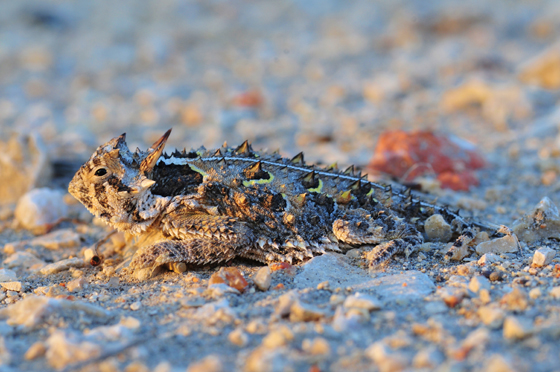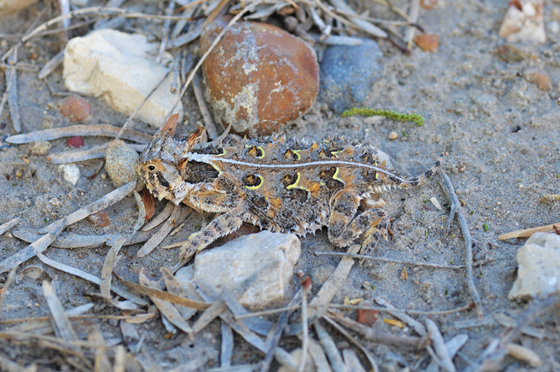Texas Horned Lizards

2025 Spring Antiques Show | March 20 – April 6
2025 Fall Antiques Show | October 4 – 18
Few species conjure up visions of the southwestern United States quite like the horned lizard. With its spines, this flat-bodied lizard fits perfectly in the sparsely vegetated, semi-arid, sandy southwestern landscape. Of the 13 recognized North American species of horned lizards, the Texas horned lizard occupied the largest range of this unique reptile family. Known to many as the horny toad or horned frog, the Texas horned lizard’s once ranged over the majority of Texas south to northern Mexico, east to Arizona and north to Kansas.
Within Texas, the lizard’s population has dropped drastically and is now believed to encompass only half of its original range here.
Causes of Decline
Dr. Scott Henke, professor at Texas A&M University-Kingsville, has been studying Texas horned lizards since the early 90s. He believes imported red fire ants, insecticide use, habitat loss, and over collection of wild-caught populations have contributed to their decline.
Ants and Insecticides
As juveniles, the Texas Horned lizards eat a variety of insects. As they mature, they feed almost exclusively on red harvester ants. Red harvester ants may make up as much as 70 percent to 90 percent of the lizard’s diet. Their highly specialized diet means Texas horned lizards are especially vulnerable to prey population fluctuations.
Imported fire ants displace the native red harvester ants by out competing them for resources. A decline in the red harvester ant population directly affects the number of Texas horned lizards that an ecosystem can sustain.
The widespread use of broadcast insecticides could also contribute to lower population numbers. Broadcast insecticides indiscriminately kill insects on which juvenile Texas horned lizards feed and, in some instances, could directly kill red harvester ants.

Habitat
Researchers have determined that the Texas horned lizard’s preferred habitat is a patchy environment that has open areas where the lizards prefer to hunt and vegetative cover, which provides protection from predators and aids in thermoregulation.
They also prefer sandy loam for nesting, bedding and hibernation. It’s believed that urbanization and the conversion of native rangeland into agricultural fields have destroyed habitat critical to Texas horned lizards.
Good land management will allow for bare spots where Texas horned lizards can hunt and red harvester ants can forage. Avoid large expanses of non-native grasses, such as Bermuda, Klein or buffelgrass that can completely cover the ground and choke out ground-dwelling critters. Native bunch grasses provide places to hide, so encourage species such as little Bluestem, big bluestem and yellow Indiangrass.
Wild Collecting and Captive Breeding
Collection of the oddly cute reptile for the commercial pet trade saw untold numbers of the lizards taken from the wild, which may have contributed to their decline. These lizards are difficult to raise in captivity. Typically, they die after just a few weeks.
Texas horned lizards don’t readily reproduce in captivity, but after many years of research, the Fort Worth Zoo’s Texas horned lizard captive breeding program has succeeded. Now the problem is reintroducing them into the wild.
TPWD biologists Nathan Rains and Devin Erxleben have been studying the viability of releasing wild-caught Texas horned lizards into areas they once occupied. A technique where the newly introduced lizards are protected in predator–resistant enclosures and slowly released into their new home is showing promise.
How to Help
It’s vital to know where horned lizards still exist, so captive-bred species can be released in a suitable location. The public can help monitor wild populations and provide data to TPWD.
It’s as easy as downloading a mobile app developed by the TPWD Diversity Program to your smart phone. The app allows the public to contribute to scientific research by reporting sightings of the Texas horned lizard and other rare plant and wildlife species.
The free app is available from the App Store and Google Play under the name “Texas Nature Trackers.” This app also helps people identify and keep track of plants and animals they observe on their land.
[line]
Another Way to Help
Purchase a conservation license plate for your car, truck, trailer, RV or motorcycle. Almost

75 percent of the $30 annual fee goes directly to projects benefiting non-game research including the Texas horned lizard and conservation education programs.
Learn more by visiting
https://conservation-plate.org
[line]
by Kelly Norrid
Urban Biologist
The Roundtopolis is home to wildlife and habitat. The Register is proud to offer information from the biologists at Texas Parks & Wildlife Department in both the wildlife and urban wildlife programs. For more information about wildlife programs in the area, call the TPWD District Wildlife Office in La Grange at 979-968-6591, contact the Urban Wildlife Program at 210-688-6447 or find your local biologist at www.tpwd.state.tx.us. (Click on “Wildlife” and then “Find a Wildlife Biologist.”)
2025 Spring Antiques Show | March 20 – April 6
2025 Fall Antiques Show | October 4 – 18